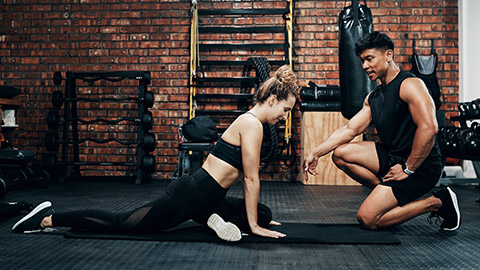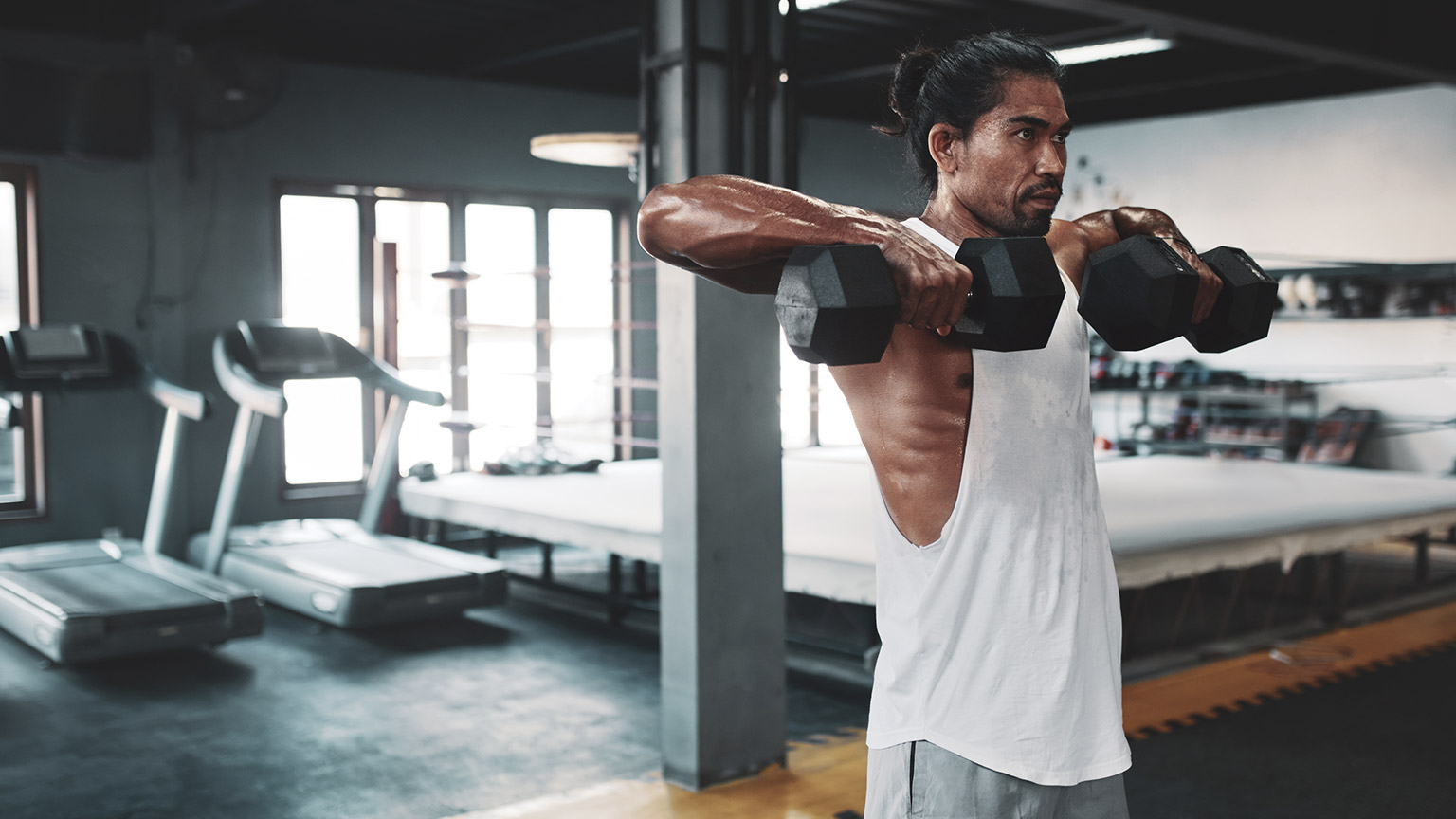Successful achievement of client goals will largely be determined by correct manipulation of resistance training variables. These variables include volume (sets and reps), intensity (load), tempo, rest intervals, and frequency.
The variables
A basic resistance programme should have at a minimum the following variables:
- Sets
- Reps
- Load
- Rest
You could also include:
- Tempo
- Intensity/RPE
Reps
A rep is one complete exercise movement. Training volume is prescribed according to the number of repetitions (or reps) per set. Reps can be classified into 3 approximate ranges:
- Low (1 – 5)
- Moderate (6 – 12)
- High (15 or more)
Low reps are optimal for increasing muscle strength, with minimal benefits to hypertrophy. Moderate reps are beneficial for hypertrophy. And high reps are best for achieving adaptations in muscular endurance.
Sets
A set is a group of consecutive repetitions of a specific exercise, with a rest interval in between sets. Using multiple sets over single sets maximises muscle strength and hypertrophy.
As a general guideline, there should be 2 – 4 sets per exercise.
Load
Load (or intensity) has the greatest influence on muscle hypertrophy and strength. It can be determined by repetition maximum (RM) - the maximum amount of weight lifted with correct technique for a given number of repetitions. E.g., 5RM is the max amount lifted with correct technique for 5 reps.
Intensities of 90-100% of 1RM are beneficial for goals related to muscular strength. 65-85% 1RM is optimal for muscular hypertrophy goals. Lower intensity of approximately 60% 1RM is sufficient for endurance-related goals.
Rest intervals
A rest interval is the length of time between the end of one set to the start of another set or exercise. Rest periods can have a significant influence on the adaptive response to resistance training and are largely related to intensity (load) applied.
Rest intervals can be classified into 3 approximate ranges:
- Short (30-60 seconds or less)
- Moderate (1 - 2 minutes)
- Long (3 minutes or more)
Short rest periods are best for training muscular endurance, where you want light loads at high repetitions.
Moderate rest periods are beneficial for hypertrophy training with moderate reps of moderate-to-heavy loads.
Long rest periods are beneficial for strength and power. Exercises are performed with heavy loads. Longer rest periods allow energy systems to be replenished (Cooke, n.d.).
Tempo
Tempo is the speed at which reps are performed and divided into 3 contractions:
- Eccentric (lowering)
- Isometric (static)
- Concentric (lifting)
Tempo is expressed in seconds, in 4 parts: eccentric – pause – concentric – pause. E.g., 3-1-2-1 means 3 second eccentric lowering, 1 second isometric hold in the bottom position, 2 second concentric raise, a second isometric hold in the top position.
Assigning variables
The following table summarises general guidelines for assigning volume and rest based on training goal.
| Training goal | Reps | Sets | Rest |
|---|---|---|---|
| Muscular endurance | 12+ | 1-2 | 30-60 seconds |
| Toning and shaping | 10-15 | 2-3 | 1 minute |
| Hypertrophy | 6-12 | 3-4 | 1-2 minutes |
| Muscular power | 6-8 | 3-4 | 3-5 minutes |
| Muscular strength | 1-6 | 3-5 | 3-5 minutes |
Recording variables
Any well-designed programme, once explained to a client, should be able to be picked up by anyone and performed safely. This means that each programme should be clear, well written, and leave no confusion about how and when to perform each movement.
If you are absent and another trainer is covering for you, they should be able to read and understand the programme easily. Clients will be expected to perform their programme on days without you, so they need to be able to understand what it says as well.
Including tips or notes can assist clients to remember key coaching points when you are not there.
The measure of your influence as a personal trainer is not how the client trains when they are with you – it’s how they train when you are not there.
Let’s look at the 2-day split programme we introduced in Exercise Selection. Note how all the essential information about variables is recorded, alongside coaching notes. This time, we’ve included the second day.
Jen 2-Day Split Training Programme
| Sunday | Monday | Tuesday | Wednesday | Thursday | Friday | Saturday |
|---|---|---|---|---|---|---|
| Yoga | Weights - lower | Bootcamp | Weights - upper | Bootcamp | Weights - lower | Long run |
Weights - lower
Warm-up: Cycle 15 Calories
Stretches: Dynamic Stretches (Lunge Hug, Side Squats, Walk the dog)
Activation: Glute Bridge with abduction x 10 reps
Potentiation: 10 reps of BB squat with just bar
| Exercise | Rest | Set 1 | Set 2 | Set 3 | Load | Notes |
|---|---|---|---|---|---|---|
| Barbell back squat | 90s | 10 35kg |
8 40kg |
6 45kg |
Hinge through hips | |
| Bulgarian split squat | 60s | 10 7kg |
10 7kg |
Drive through heels | ||
| Leg press | 10 83kg |
10 83kg |
Soft lock 15kg per side |
|||
| Dumbbell Romanian Dead Lift | 60s | 10 12kg |
10 12kg |
10 12kg |
Keep back flat | |
| Jump squats | 30s | 30s | 30s | 30s | As much height as possible | |
| Dead hang | 40s | 40s | Brace core, feet forward | |||
| Weighted plank | 40s 5kg |
40s 5kg |
Stay square |
Weights - Upper
Warm-up: Rower 500m
Stretches: Dynamic stretches (thread the needle, cat/cow, back pats)
| Exercise | Rest | Set 1 | Set 2 | Set 3 | Load | Notes |
|---|---|---|---|---|---|---|
| Barbell benchpress | 90s | 6-10 | 6-10 | 20kg | Full ROM | |
| Dumbbell flyes | 12 | 12 | 5kg | Big hug | ||
| Inverted row | 60s | 8 | 8 | Elbows close | ||
| Upright row | 8-10 | 8-10 | 15kg | Lead with elbows | ||
| Curl'n'press | 60s | 10 | 10 | 4kg | Twist through ROM | |
| Dumbbell kicks | 10 | 10 | 3kg | Elbows high | ||
| Medicine ball crunch | 60s | 10/10 | 10/10 | 3kg | Eyes on ceiling | |
| Medicine ball Russian twist | 10 | 10 | 3kg | 45 only | ||
| Medicine ball leg raises | 10 | 10 | 3kg | Shins to ball |
Programme Notes:
This programme is a progression from the full body programme you have been following. It will allow you to dedicate a bit more focus and energy to individual areas.
Ensure you stretch in between sets. Aim to increase the load as you get more accustomed to the movements.
We will change this programme in another 6-weeks' time.
Warm-up, cool-down, and stretches

The warm-up is an essential programme component. It helps reduce muscle soreness by ensuring muscles are well supplied with oxygen and reduces the risk of injury by elevating the heart rate and body temperature slowly to minimise the stress on the heart.
Low-intensity cardio exercises are a standard warm-up activity to help prepare the cardiovascular and respiratory systems for the upcoming activity. As discussed in Exercise Prescription A, after the cardio warm-up, it's important to do some activation and mobilisation work to ensure clients are fully ready to exercise
A post work-out cool-down is just as important as a warm-up. Once the main body of the workout (conditioning component) has been completed, the heart rate remains elevated, requiring time to return to resting. Abruptly ceasing exercise may create other issues including a build-up of lactic acid, which can lead to muscle cramping and stiffness or pooling of the blood in the veins leading to damage of their structural walls.
Implementing stretching within a programme is effective as it supports decreasing heart rate and stretching muscles, preparing them for rest and recovery. Depending upon the exercises selected and the client's training level, stretching may be performed in the warm-up or the cool-down session, or both.
Examples of cooling down practices may include:
- Low-intensity exercises
- Light body weight exercises including lunges and squats
- Foam rolling to increase blood flow and the breakdown of lactic acid and knots within the muscle
- Static stretching

For many people, committing to a training programme typically does not last long term. Boredom can kick in along with other demotivators and distractions which can lead to clients reducing then discontinuing their training. The important question each fitness professional should ask themselves, how can I ensure each training session is exciting and valuable to ensure the client continues working towards their goal?
Working with a personal trainer in itself can be a huge motivator for some people. However, other strategies should also be implemented within the training programme to support the client in remaining motivated and eager to progress. Some of these include:
- Ensure the training plan is realistic. The trainer will start off with light activity and gradually increase duration and intensity as the client progresses.
- Ensure the client enjoys the training exercises prepared for them. The personal trainer should tailor the training plan to suit them and what they enjoy, as well as encourage them to do exercises that work best to achieve their goals.
- Develop goals (both short and long term) that are achievable and realistic. As the client sees themselves achieving small goals, it will boost their motivation to continue.
- Enforce flexibility to cater to the client’s personal requirements. Everybody is different and their commitments may change from time to time, so being able to train at a time/location that is suitable to the client will encourage them to continue.
- No time-wasting! Minimise time-wasting and maximise results. Clients want to have effectively designed programmes that provide them with the right tools to maximise results.
- Develop a positive relationship with your client where they can feel comfortable discussing any concerns and struggles. Develop a plan that minimises the risk of injury.
- Do not overdo it. If a trainer develops a plan that consists of high intensity exercise 5 days a week, this can increase the risk of injury and become a demotivator. The training plan needs to consist of high intensity, low intensity, and stretching days to support the client’s rest and recovery.
Programme Monitoring and Re-evaluation
A health and fitness professional will typically write hundreds of programmes in their lifetime and perform just as many programme re-evaluations. Why? Self-improvement.
Guaranteed, any programme which has been well designed behind the scenes, ready and waiting for the client to walk in and begin their first session, will likely not run 100% to plan. This could be for a multitude of reasons that may include the following:
- The client is late
- The client is tired
- The client slept funny and has a sore neck/back
- The client didn’t sleep well due to stress and is feeling tired
- The machine you wish to use is taken by another member
- The client is feeling unwell
There are many other reasons which cannot always be controlled.
A large part of the trainer's role is to be prepared. To continue delivering amazing sessions to clients, it’s important to monitor and evaluate the programme and the services given to the client both during and after each session. An example of this may include, seeking verbal feedback from the client through these stages.
Before the session
Ask yourself:
- Is the prescribed programme at the correct level for the client?
- What will the plan be if someone is using the equipment required, what is the back-up plan?
During the session
Ask yourself:
- Is the client performing the exercises correctly? If the client is struggling it is the responsibility of the trainer to find an alternative way to communicate the requirements. For instance, adjusting language, visual demonstration and so on.
- Is my verbal delivery suitable for the client, do I need to rephrase my wording?
After the session
Ask yourself:
- Did the session run as planned, or did it require any programme adjustments?
- Did anything happen within the session which I was not expecting/prepared for?
- Did I have enough alternative exercises prepared to ensure the session remained smooth in the event of other people using the equipment which was required or the inability of the client to perform the planned exercise efficiently and safely?
- Was my verbal delivery correctly pitched for the client?
- Could my demonstrations be tweaked in future to better support clients?
- Was the programme clear? Did the client understand what exercises were to be performed and how to perform them?
- Was there adequate time to get through the programme?
Self-evaluation versus client feedback
Programme monitoring and re-evaluation can and should be performed through self-evaluation and client feedback. Self-evaluation is not commonly practised within the industry. Why would an awesome program need to be self-evaluated? For the reasons above, that is why! Any professional trainer worth their salt would want to continuously improve by reflecting on what they can control within a session.
Another extremely effective way to ensure a smooth session and programme design is to seek feedback from the client. This can be obtained by watching them perform the exercises and gauging their RPE and listening to their verbal feedback. It can also be further obtained by asking them after the session what they felt worked well and what they felt could work better. There is no pride lost in asking for feedback. In fact, both trust and respect are gained by asking for further information to ensure they have a safe and effective experience. This type of professional conduct will be what sets you above the rest.

Desirable Training Response

Your goal as a fitness coach is to coach your client effectively and gain desirable training responses. A desirable training response is the positive physiological and psychological changes that occur in response to a well-designed exercise programme. This should incorporate a variety of exercises and training modalities to ensure a well-rounded and balanced approach. Additionally, the programme should be progressive, meaning it gradually increases in intensity and complexity over time, to continue challenging the body and promoting adaptation. Desirable training responses include:
- Improvements in fitness
- Strength, endurance
- Flexibility
- Improved mood
- Self-confidence
- Overall health and quality of life
Building rapport
Building rapport is about creating a strong and trustworthy relationship with your client. At the core of being able to build rapport with your client, you must be client-centred approach. This involves focusing on the needs, preferences, and goals of the client, and tailoring the coaching process to their unique circumstances.
Building rapport with a client is an essential component of effective fitness coaching. When a client feels comfortable and connected with their coach, they are more likely to trust their guidance and stay motivated to achieve their goals.
Here are some ways a fitness coach can build rapport with their client.
- Active listening: By giving your full attention and being present in the moment, you can show your client that you value their input and are committed to understanding their needs and goals.
- Empathy: Showing empathy and understanding towards your client's challenges and struggles can help build a deeper connection and trust. By acknowledging their feelings and validating their experiences, you can create a safe and supportive environment where they feel heard and understood.
- Personalisation: Taking the time to understand your client's unique needs and preferences can help build rapport and trust. By tailoring your coaching approach to their specific goals, fitness level, and personality, you can show that you are invested in their success and are committed to helping them achieve their goals. This principle involves assessing during a fitness test and addressing the client's strengths, weaknesses, and goals to create a programme that is tailored to their specific needs.
- Positive reinforcement: Providing positive feedback and reinforcement can help build rapport and boost your client's confidence. By acknowledging and celebrating their achievements, you can help them feel motivated and supported throughout their fitness journey. Overall, building rapport with a client involves creating a safe and supportive environment where they feel heard, understood, and motivated to achieve their goals.
Watch
Having a structure to a session can really help a trainer provide strong service to their clients. Watch this short tutorial on how to structure a session along with a few example clips on how to open and close a session.
Coaching our clients through resistance training is a crucial and common aspect of our job. Here Ben talks through the NAMEDCAT coaching model which helps structure our coaching process.
See the NAMEDCAT coaching system in action with this example of coaching the barbell back squat.
Motivation and support
There are several types of motivation that a fitness coach can provide to support and coach their clients on their fitness journey. The following table provides some examples of each type of motivation a fitness coach can provide to their client’s.
To achieve desirable training responses, we know that we must follow some effective coaching principles. The following summarises how to accomplish this.
| Type of Motivation | Description | Example |
|---|---|---|
| Intrinsic motivation | This type of motivation comes from within the individual and is driven by personal satisfaction and a sense of accomplishment. | Encouraging a client to focus on how exercise makes them feel, such as the sense of accomplishment after a challenging workout, or the boost in energy they feel throughout the day. |
| Extrinsic motivation | This type of motivation comes from external sources such as rewards, praise, and recognition. | Celebrating a client's achievements with verbal praise, or rewarding them with a small gift or treat for hitting a milestone. |
| Social motivation | This type of motivation comes from social connections and support. | Creating a supportive environment where clients can connect with other like-minded individuals, such as organising group fitness classes or events. |
| Educational motivation | This type of motivation comes from knowledge and understanding of the benefits of exercise and healthy habits. | Sharing educational resources and information about the benefits of exercise, such as explaining the science behind how exercise helps reduce stress and improve mental health. |
| Goal-oriented motivation | This type of motivation comes from setting and achieving specific goals. | Helping a client set a specific goal, such as running a 5K or being able to lift a certain amount of weight, and providing guidance and support to help them work towards achieving that goal. |
Overall, by providing a range of motivational strategies, a fitness coach can help their clients stay motivated and committed to their fitness journey, leading to better outcomes and a more positive experience.
Try it out
Sometimes- to help motivate clients, all you need to do is put yourself in their shoes or perhaps, you can relate. Being relatable and having empathy can guide you in how to handle tricky conversations that will inspire and motivate your client.
Consider your own experiences to better understand what your clients may need from you to stay on track with their training and nutrition.
Isn’t it great to dive into our own minds to discover what drives us towards our goals? What can knock us about and more importantly, how much we can achieve when we don’t give up? In the words of Maya Angelou,
We may encounter many defeats but we must not be defeated.Maya Angelou
Undesirable Training Responses

In an ideal world, fitness coaching will always have desirable training responses. However, it is unrealistic to never experience undesirable training responses. It is important that you know how to recognise an undesirable training response as well as how to respond to one. Let’s take a look at some of these in detail:
Undesirable training responses: Acute
Acute training responses are the immediate physiological changes that occur during and after a single bout of exercise. These responses may include fatigue, soreness, inflammation, and decreased performance. Acute training responses are typically short-lived and are expected to dissipate within a few hours to days.
The following lists signs you can look out for to identify if your client is having an acute training response:
- Closed body language
- Red face
- In pain/sore
- Nausea
- Negative about workout
- Dizziness
- Avoidance
- Disengaged
- Unconscious/Dead
- Injury
- Pale/Pasty Skin
- Excessive Sweat
- No sweat at all
- Inability to complete
Undesirable training responses: Chronic
Chronic training responses refer to the long-term adaptations that occur over weeks, months, or even years of consistent exercise.
These adaptations may include improved muscular strength and endurance, increased cardiovascular fitness, and changes in body composition.
Chronic training responses are desirable and are the primary goal of most fitness programmes.
However, if the training stimulus is too intense, too frequent, or too prolonged, it can lead to chronic undesirable training responses such as overtraining, injury, and burnout.
These chronic undesirable training responses can result from an imbalance between the training stimulus and the body's ability to recover and adapt. Therefore, fitness coaches need to monitor and adjust the training stimulus to ensure their clients progress towards their goals while minimising the risk of chronic undesirable training responses.
Poor training adaptations

Poor training adaptations refers to an inadequate or negative response to a training stimulus. It can occur when the training programme is not well-designed or the individual does not have the necessary recovery time between workouts. This can result in little or no progress or even decreased performance or physical capacity.
The following lists signs and symptoms of poor training adaptions.
- No improvement/regression
- Negativity towards training
- Lack of commitment
- Chronic Fatigue
- Complaining of soreness/chronic DOMS
- Poor motivation/regularly cancelling sessions
- Struggling to complete workouts
Reasons for negative responses
Both the client and fitness coach can be the cause of an undesirable response has occurred. The following table lists reasons for undesirable training caused by…
| The fitness coach | The client |
|---|---|
|
|
Rectifying poor adaptions
When looking at the training holistically, you can analyse areas that may need adapting to achieve a desirable response. Some actions to rectify poor adaptations may include:
- Look at the overall exercise prescription
- Change frequency
- Change intensity
- Change duration
- Change the type of exercise
- Try to find common ground with the client
- Doctor/Physio referral
- Give more education in other areas
- Stress
- Nutrition
- Sleep
- Accommodate for their changed circumstances
- Look at screening/testing procedures
- Re-test, re-interview if necessary
- Look in the mirror, ask yourself, “is there anything else I could do to improve the sessions?”
Other undesirable responses
The following is a list of other undesirable responses that may impact your client while you are coaching.
- Client nervous/intimidated
- Too hot/humid/windy/wet
- Lack of an appropriate warm-up
- Poor nutrition
- Malnourished
- Eaten too close to workout
- Hungover
- Drunk
- Dehydrated
- Too much caffeine
- Sick/Ill
- Lack of sleep
- External stress
- FITT Principles mismanaged by trainer:
- Too close together
- Too intense
- Too long
- Too advanced
- Poor screening process
- Undisclosed medical condition
- Misinterpretation of fitness levels/exercise history
- Session not specific to client goals
Responding to undesirable responses
Many strategies can provide a solution to this problem. Look at the following list to help you decide which action should be taken, depending on the type of undesirable response you are dealing with.
- Reassurance/chat with them
- Lower the intensity
- Better monitoring processing
- Education on session preparation
- Change location
- Fanning them/cooling them down
- Altering the session based on client's state
- Recovery position
- Administer first aid
- Stop the session
- Regress the exercises/scale
- Better screening process
- Refer to Doctor/Physio
- Drink water/ingest carbohydrates
For your second assessment in this module, you will be conducting a full programme design with a client, as mentioned in the module overview video, this assessment encapsulates all your theoretical knowledge into a practical task – pre-screening and testing a client, creating a plan and a programme, delivering/implementing the programme, and then updating it based on progress review.
For this assessment, you will need a client, a supervisor/observer, and permission from the gym to train someone.
As a reminder, here are the details of the client:
- Aged 18 – 65 years old
- No major injuries that would prevent them from performing basic movements in the gym
- No medical conditions (such as high blood pressure, history of cardiac events, moderate-severe asthma, pregnant or lactating, or have any other medical condition that would put them at high risk for exercise)
- Able to access the gym or training area that you attend (i.e., also be a member of the gym you are wanting to train them out of)
- Available to train with you several times per week for multiple weeks, and
- Someone who is not a high-level competitive athlete training for a specific sport (we do not want to interfere with their training regime).
A quick reminder that your supervisor must meet the following criteria.
- REPs registered in category c) Personal Trainer (PT)
- PT Employee: Provide the services of an Exercise Consultant Level II PLUS provide personal training services with an exercise facility setting.
- PT Contractor: Provide the services of an Exercise Consultant Level II PLUS provide personal training services at any setting/venue, operating as an independent business.
- Personal Trainer with at least 1 year experience in the industry – must hold a New Zealand Certificate in Exercise Level 4 or above or an equivalent qualification in a similar field
- Gym manager with an equivalent New Zealand qualification in Exercise at Level 4 or above or an equivalent qualification in a similar field
By the time you begin your Programme Design assessment, you should have already completed and submitted your letter of introduction task.
It is important to get this assessment started in week 7 if you are full time, and week 12 if you are part time. Check out the overview video in the assessment tab for guidance around this assessment, and always check in with your tutor early if you are having difficulty finding a client or a supervisor.
